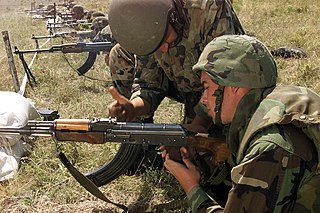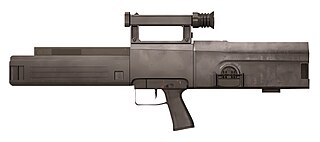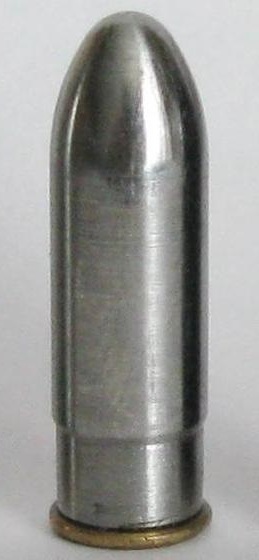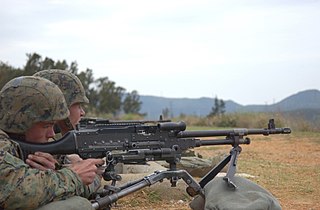
A squad automatic weapon (SAW), also known as a section automatic weapon or light support weapon (LSW), is a man-portable automatic firearm attached to infantry squads or sections as a source of rapid direct firepower. Weapons fulfilling this role can be light machine guns, or modified selective-fire rifles fitted with a heavier barrel, bipod and a belt/drum-fed design.

The Bren gun was a series of light machine guns (LMG) made by Britain in the 1930s and used in various roles until 1992. While best known for its role as the British and Commonwealth forces' primary infantry LMG in World War II, it was also used in the Korean War and saw service throughout the latter half of the 20th century, including the 1982 Falklands War. Although fitted with a bipod, it could also be mounted on a tripod or be vehicle-mounted.

The IWINegev is a 5.56×45mm NATO light machine gun developed by Israel Weapon Industries (IWI), formerly Israel Military Industries Ltd. (IMI).
The M60, officially the Machine Gun, Caliber 7.62 mm, M60, is a family of American general-purpose machine guns firing 7.62×51mm NATO cartridges from a disintegrating belt of M13 links. There are several types of ammunition approved for use in the M60, including ball, tracer, and armor-piercing rounds.

The Heckler & Koch G11 is a non-production prototype assault rifle developed from the late 1960s–1980s by Gesellschaft für Hülsenlose Gewehrsysteme (GSHG), a conglomeration of companies headed by firearm manufacturer Heckler & Koch, Dynamit Nobel, and Hensoldt Wetzlar. The rifle is noted for its use of caseless ammunition.

Caseless ammunition (CL), or caseless cartridge, is a configuration of weapon-cartridge that eliminates the cartridge case that typically holds the primer, propellant and projectile together as a unit. Instead, the propellant and primer are fitted to the projectile in another way so that a cartridge case is not needed, for example inside or outside the projectile depending on configuration.

The FN Minimi is a Belgian 5.56mm light machine gun, also classified as a squad automatic weapon developed by Ernest Vervier for FN Herstal. Introduced in the late 1970s, it is in service in more than 75 countries. The weapon is manufactured at the FN facility in Herstal and their U.S. subsidiary FN Manufacturing LLC.

A medium machine gun (MMG), in modern terms, usually refers to a belt-fed machine gun firing a full-powered rifle cartridge, and is considered "medium" in weight. Medium machine guns are light enough to be infantry-portable, but still cumbersome enough to require a crew for optimal operational efficiency.

The Mark 48, or Mk 48, is a belt-fed general-purpose machine gun chambered for 7.62×51mm NATO cartridges, fed from a disintegrating belt or the non-disintegrating segmented German DM1 belt of ammunition.
Ares Incorporated is an American weapons manufacturer and firearms engineering company co-founded by the American weapons inventor and developer Eugene Stoner in 1971. The company is based in Port Clinton, Ohio, and produces fire control systems, turret systems, small arms, automatic cannons and industrial machinery. Mr. Stoner left the company in 1989, joining Knight's Armament Company in 1990, where his designs included the Stoner 96, a further refinement of the Ares LMG/Stoner 63.
The Lightweight Small Arms Technologies (LSAT) program is funded by the U.S. Joint Service Small Arms Program, with the goal of significantly reducing the weight of small arms and their ammunition. Following a series of military programs to investigate advances in small arms, the LSAT program is the US military's latest project to replace existing US small arms. Tactical concepts and the research from the previous small arms programs indicates that lightening small arms is the first significant step towards increasing soldiers' lethality and survivability.
The LSAT rifle, of the LSAT program, is a developmental assault rifle. Design began in 2008, four years after the beginning of the LSAT program. Like the LSAT LMG, the rifle is designed to be significantly lighter than existing designs, and is designed to fire lighter ammunition. Like the rest of the program, the weapon extensively uses parallel development. It has designs for polymer-cased ammunition and caseless ammunition, and designs using spring-loading magazines and weapon-powered magazines. This parallel development reduces the risk of the program failing. Computer simulation and modelling, particularly of the LMG, is being used for all components of the program, including the rifle. This reduces both time and expenditure for prototyping and testing. The other program components use a 'spiral development' approach, whereby the product is rolled out in stages or 'spirals', each stage producing a new version that is an improvement on those from previous spirals; the rifle shall likely use the same approach. The weapon and the program are closely connected to the Future Force Warrior concept, with aims to integrate electronics and computerized optics, and aims to increase the mobility of soldiers. The weapon is also intended to improve on reliability and ease of maintenance.

LSAT caseless ammunition is caseless ammunition produced as part of the U.S. Army’s Lightweight Small Arms Technologies (LSAT) program.

The M249 SAW, formally written as Light Machine Gun, 5.56 mm, M249, is the US military's adaptation of the Belgian FN Minimi, a light machine gun manufactured by FN Herstal (FN).

Telescoped ammunition is an ammunition design in which the projectile is partially or completely enveloped by the propellant. Examples include ammunition for both hand weapons and artillery. Caseless ammunition is often telescoped.

Polymer-cased ammunition (PCA) is firearm ammunition (cartridge) with casings made from synthetic polymer instead of the typical metallic casing. PCA is considered a new alternative that potentially reduces production cost and weight for long guns and handguns.
The .277 Fury or 6.8×51mm Common Cartridge, is a centerfire rimless bottlenecked rifle cartridge announced by SIG Sauer in late 2019. Its hybrid three-piece cartridge case has a steel case head and brass body connected by an aluminum locking washer to support the high chamber pressure of 80,000 psi (551.6 MPa).

The Next Generation Squad Weapon (NGSW) program is a United States military program created in 2017 by the U.S. Army to replace the 5.56mm M4 carbine, the M249 SAW light machine gun, and the 7.62mm M240 machine gun, with a common system of 6.8mm cartridges and to develop small arms fire-control systems for the new weapons.

The XM250 is the U.S. military designation for the SIG LMG 6.8, a 6.8×51mm, gas-operated, belt-fed, light machine gun designed by SIG Sauer for the U.S. Army's Next Generation Squad Weapon Program in 2022 to replace the M249 light machine gun. The XM250 light machine gun features a free-floating reinforced M-LOK handguard for direct accessory attachment onto the "negative space" mounting points.

















